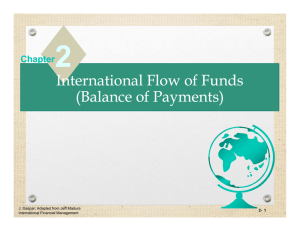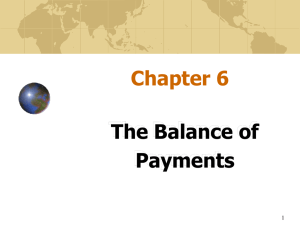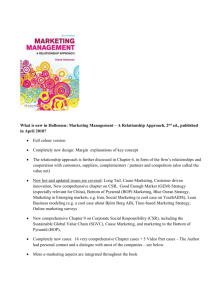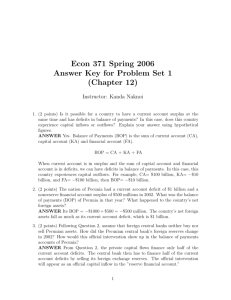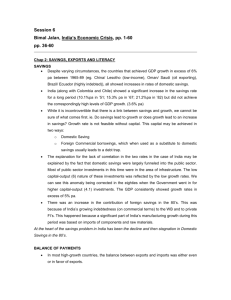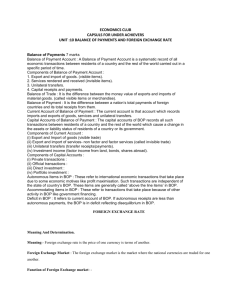Balance of Payments - Dixie State University
advertisement
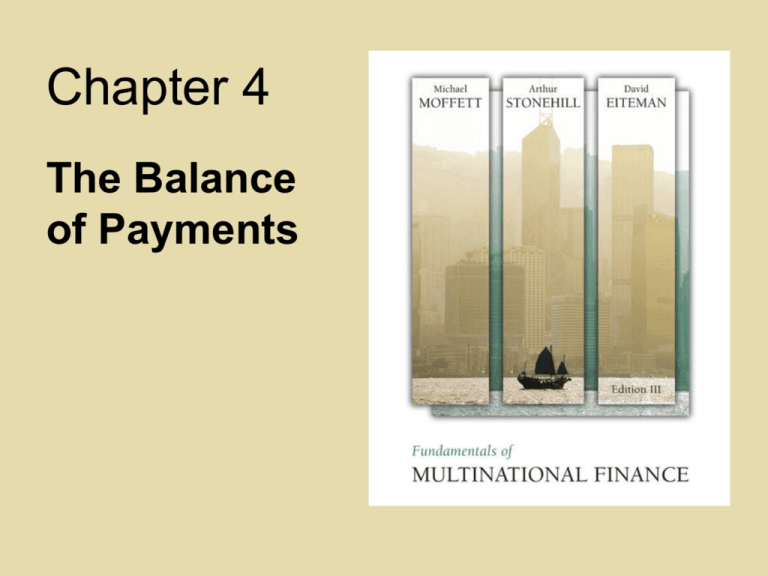
Chapter 4 The Balance of Payments The Balance of Payments: Learning Objectives • Learn how nations measure their own levels of international economic activity, and how that is measured by the balance of payments • Examine the economic relationships underlying the two basic sub-components of the balance of payments – the Current and Capital Accounts • Consider the financial dimensions of international economic activity, and how they differ between merchandise & services trade 4-2 The Balance of Payments • Identify balance of payment activities by nations in pursuit of macroeconomic policies • Examine how exchange rate changes and volatility influence trade balances over time • Evaluate the history of capital mobility, and conditions that lead to capital flight in times of crisis 4-3 The Balance of Payments • The measurement of all international economic transactions between the residents of a country and foreign residents is called the Balance of Payments (BOP) – The IMF is the primary source of similar statistics worldwide – Multinational businesses use various BOP measures to gauge the growth and health of specific types of trade or financial transactions by country and regions of the world against the home country 4-4 The Balance of Payments – Monetary and fiscal policy must take the BOP into account at the national level – Businesses need BOP data to anticipate changes in host country’s economic policies driven by BOP events – BOP data may be important for the following reasons • BOP is important indicator of pressure on a country’s exchange rate, thus potential to either gain or lose if firm is trading with that country or currency • Changes in a country’s BOP may signal imposition (or removal) of controls over payments, dividends, interest, etc • BOP helps to forecast a country’s market potential, especially in the short run 4-5 Typical BOP Transactions • Examples of BOP transactions from US perspective – Honda US is the distributor of cars manufactured in Japan by its parent, Honda of Japan – US based firm, Fluor Corp., manages the construction of a major water treatment facility in Bangkok, Thailand – US subsidiary of French firm, Saint Gobain, pays profits (dividends) back to parent firm in Paris – An American tourist purchases a small Lapponia necklace in Finland – A Mexican lawyer purchases a US corporate bond through an investment broker in Cleveland • A rule of thumb that aids in understanding the BOP is to “follow the cash flow” 4-6 Exhibit 4.1 Generic Balance of Payments 4-7 Fundamentals of BOP Accounting • The BOP must balance • Three main elements of actual process of measuring international economic activity – Identifying what is/is not an international economic transaction – Understanding how the flow of goods, services, assets, money create debits and credits – Understanding the bookkeeping procedures for BOP accounting 4-8 Defining International Economic Transactions • Current Account Transactions – The export of merchandise, goods such as trucks, machinery, computers is an international transaction – Imports such as French wine, Japanese cameras and German automobiles are international transactions – The purchase of a glass figure in Venice by an American tourist is a US merchandise import • Financial Account Transactions – The purchase of a US Treasury bill by a foreign resident 4-9 BOP as a Flow Statement • Exchange of Real Assets – exchange of goods and services for other goods and services or for monetary payment • Exchange of Financial Assets – Exchange of financial claims for other financial claims 4-10 The Current Account • Goods Trade – export/import of goods. • Services Trade – export/import of services; common services are financial services provided by banks to foreign investors, construction services and tourism services • Income – predominately current income associated with investments which were made in previous periods. Additionally the wages & salaries paid to non-resident workers • Current Transfers – financial settlements associated with change in ownership of real resources or financial items. Any transfer between countries which is one-way, a gift or a grant,is termed a current transfer • Typically dominated by the export/import of goods, for this reason the Balance of Trade (BOT) is widely quoted 4-11 Exhibit 4.2 The United States Current Account, 1998-2005 (billions of U.S. dollars) 4-12 Exhibit 4.3 U.S. Trade Balance and Balance on Services and Income, 1985-2005 (billions of U.S. dollars) 4-13 The Capital and Financial Accounts • Capital account is made up of transfers of fixed assets such as real estate and acquisitions/disposal of nonproduced/non-financial assets • Financial account consists of three components and is classified either by maturity of asset or nature of ownership. The three components are – Direct Investment – Net balance of capital which is dispersed from and into a country for the purpose of exerting control over assets. This category includes foreign direct investment 4-14 The Capital and Financial Accounts – Portfolio Investment – Net balance of capital which flows in and out of the country but does not reach the 10% ownership threshold of direct investment. The purchase and sale of debt or equity securities is included in this category • This capital is purely return motivated – Other Investment Assets/Liabilities – Consists of various short and long-term trade credits, cross-border loans, currency and bank deposits and other accounts receivable and payable related to cross-border trade 4-15 Exhibit 4.4 The United States Financial Account and Components, 1998-2005 (billions of U.S. dollars) 4-16 Exhibit 4.5 The United States Financial Account, 1985-2005 (billions of U.S. dollars) 4-17 Exhibit 4.6 Current and Combined Financial/Capital Account Balances for the United Sates, 1992-2005 (billions of U.S. dollars) 4-18 The Other Accounts • Net Errors and Omissions – Account is used to account for statistical errors and/or untraceable monies within a country • Official Reserves – total reserves held by official monetary authorities within a country. – These reserves are typically comprised of major currencies that are used in international trade and financial transactions and reserve accounts (SDRs) held at the IMF – Under a fixed rate regime official reserves are more important as the government assumes the responsibility to maintain parity among currencies by buying or selling its currency on the open market – Under a floating rate regime the government does not assume such a responsibility and the importance of official reserves is reduced 4-19 Balance of Payments Interaction with Key Macroeconomic Variables • A nation’s balance of payments interacts with nearly all of its key macroeconomic variables: – – – – Gross domestic product (GDP) The exchange rate Interest rates Inflation rates 4-20 Exhibit 4.7 The United States Balance of Payments, Analytic Presentation, 1995-2005 (billions of U.S. dollars) 4-21 Exhibit 4.7 The United States Balance of Payments, Analytic Presentation, 19952005 (billions of U.S. dollars) (cont.) 4-22 Balance of Payments Interaction with Key Macroeconomic Variables • In a static (accounting) sense, a nation’s GDP can be represented by the following equation: GDP = C + I + G + X – M C I G X M = consumption spending = capital investment spending = government spending = exports of goods and services = imports of goods and services X–M= Current account balance 4-23 The Balance of Payments and Exchange Rates • A country’s BOP can have a significant impact on the level of its exchange rate and vice versa depending on that country’s exchange rate regime • The effect of an imbalance in the BOP of a country works somewhat differently depending on whether that country has fixed exchange rates, floating exchange rates, or a managed exchange rate system – Under a fixed exchange rate system the government bears the responsibility to assure a BOP near zero – Under a floating exchange rate system, the government of a country has no responsibility to peg its foreign exchange rate 4-24 The Balance of Payments and Exchange Rates • The relationship between BOP and exchange rates can be illustrated by use of a simplified equation: Current Capital Financial Reserve Balance Account Balance Account Balance Account Balance Balance of Payments (X-M) + (CI - CO) + (FI - FO) + = (FXB) BOP CI = capital inflows CO = capital outflows FI = financial inflows FO = financial outflows FXB = official monetary reserves 4-25 The Balance of Payments and Interest Rates • Apart from the use of interest rates to intervene in the foreign exchange market, the overall level of a country’s interest rates compared to other countries does have an impact on the financial account of the balance of payments • Relatively low interest rates should normally stimulate an outflow of capital seeking higher interest rates in other country-currencies • In the U.S. however, the opposite has occurred as a result of attractive growth rate prospects, high levels of productive innovation, and perceived political stability 4-26 The Balance of Payments and Inflation Rates • Imports have the potential to lower a country’s inflation rate • In particular, imports of lower priced goods and services places a limit on what domestic competitors charge for comparable goods and services 4-27 Trade Balances and Exchange Rates • A simple concept in principle: Changes in exchange rates changes the relative prices of imports and exports which in turn result in changes in quantities demanded • In reality the process is less straight-forward 4-28 The J-Curve Adjustment Path • Trade balance adjustment occurs in three stages over a varying and often lengthy period of time 1. The currency contract period – Adjustment is uncertain due to existing contracts that must be fulfilled 2. The pass-through period – Importers and exporters must eventually pass along the cost changes 3. Quantity adjustment period – – The expected balance of trade is eventually realized U.S. trade balance = (P$xQx) – (S$/fc PfcM QM) 4-29 Exhibit 4.8 Trade Balance Adjustment to Exchange Rate Changes: The J-Curve 4-30 Capital Mobility • The degree to which capital moves freely cross-border is critically important to a country’s balance of payments • Historical patterns of capital mobility – 1860-1914 – period characterized by continuously increasing capital openness as more countries adopted the gold standard and expanded international trade relations – 1914-1945 – period of global economic destruction due to two world wars and a global depression – 1945-1971 – Bretton Woods era, saw great expansion of international trade in goods and services – 1971-2002 – period characterized by floating exchange rates, economic volatility, but rapidly expanding cross-border capital flows 4-31 Exhibit 4.9 A stylized View of Capital Mobility in Modern History 4-32 Capital Flight “International flows of direct and portfolio investments under ordinary circumstances are rarely associated with the capital flight phenomenon. Rather, it is when capital transfers by residents conflict with political objectives that the term “flight” comes into general usage.” —Ingo Walter, Capital Flight and Third World Debt 4-33 Capital Flight • Five primary mechanisms exist by which capital may be moved from one country to another: – Transfers via the usual international payments mechanisms, regular bank transfers are easiest, cheapest and legal – Transfer of physical currency by bearer (smuggling) is more costly, and for many countries illegal – Transfer of cash into collectibles or precious metals, which are then transferred across borders – Money laundering, the cross-border purchase of assets which are then managed in a way that hide the movement of money and its owners – False invoicing on international trade transactions 4-34 Summary of Learning Objectives • The Balance of Payments is the summary statement of all international transactions between one country and all other countries • The Balance of Payments is a flow statement, summarizing all the international transactions that occur across the geographic boundaries of the nation over a period of time, typically a year • Although the BOP must always balance in theory, in practice there are substantial imbalances as a result of statistical errors and misreporting of current account and financial/capital account flows 4-35 Summary of Learning Objectives • The two major sub-accounts of the balance of payments, the current account and the financial/capital account, summarize the current trade and international capital flows of the country respectively • The current account and financial/capital account are typically inverse on balance, one in surplus while the other experiences deficit • Although most nations strive for current account surpluses, it is not clear that a balance on current or capital account, or a surplus on current account, is either sustainable or desirable 4-36 Summary of Learning Objectives • Although merchandise trade is more easily observed, the growth of services trade is more significant to the BOP for many of the world’s largest industrialized countries today • Monitoring of the various sub-accounts of a country’s BOP activity is helpful to decision-makers and policymakers on all levels of government and industry in detecting the underlying trends and movement of fundamental economic forces driving a country’s international economic activity 4-37 Summary of Learning Objectives • Changes in exchange rates change relative prices of imports and exports which in turn result in changes in quantities of demanded through the elasticity of demand • A devaluation results initially in a further deterioration in the trade balance before an eventual improvement – the path of adjustment takes on the shape of a flattened “j” • The ability of capital to move instantaneously and massively cross-border has been one of the major factors in the severity of recent currency crises • Although not limited to heavily indebted countries, the rapid and sometimes illegal transfer of convertible currencies out of a country poses significant economic and political problems 4-38
